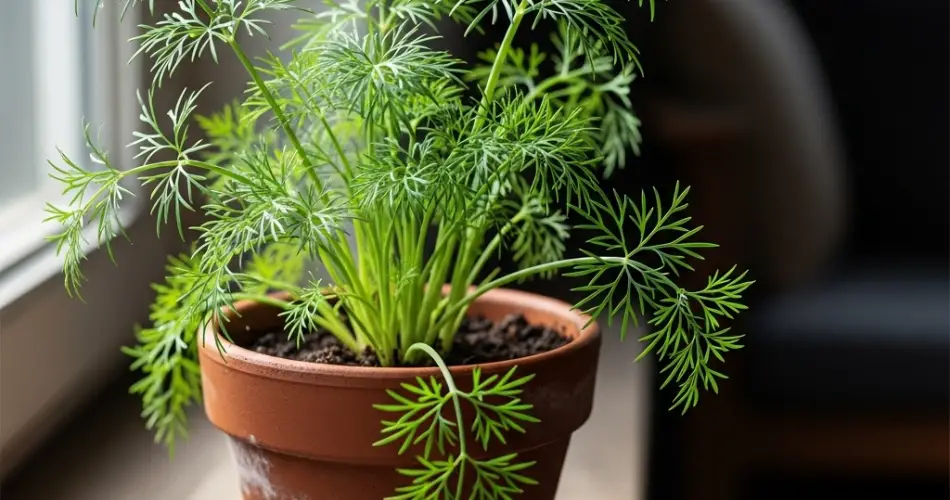Dill is a fragrant and flavorful herb prized for its feathery green leaves and aromatic seeds, making it a favorite ingredient in pickling recipes, seafood dishes, and fresh salads. Growing dill in pots is an ideal solution for gardeners with limited outdoor space or those who want fresh herbs conveniently close to the kitchen. This guide will walk you through the essentials of successfully growing dill in containers, ensuring a steady supply of fresh leaves and seeds for your culinary needs.
Why Grow Dill in Pots?
Potted dill offers several advantages:
-
Space-saving: Perfect for balconies, patios, or windowsills where garden space is limited.
-
Mobility: Easily move pots to capture optimal sunlight or protect plants from harsh weather.
-
Freshness: Having dill right at hand ensures vibrant flavor and aroma in your cooking.
-
Control: Growing in containers allows better management of soil quality and watering.
Choosing the Right Container
Selecting the right pot is key for healthy dill growth:
-
Size: Use a pot that is at least 12 inches deep and wide to accommodate dill’s long taproot.
-
Material: Terracotta or plastic pots work well; terracotta pots help with moisture evaporation, while plastic retain moisture longer.
-
Drainage: Ensure the pot has ample drainage holes to prevent waterlogging, which can harm dill roots.
Best Soil for Container Dill
Dill thrives in well-draining, fertile soil:
-
Potting Mix: Use a high-quality potting soil enriched with organic matter like compost.
-
Soil Texture: A light, loose soil mix ensures good drainage and root growth.
-
pH Level: Dill prefers slightly acidic to neutral soil, with a pH between 5.5 and 7.0.
-
Fertilizing: Apply a balanced, water-soluble fertilizer every 4-6 weeks during the growing season for best growth.
Planting Dill Seeds in Pots
Growing dill from seed is straightforward:
-
Sowing: Plant seeds about ¼ inch deep in the potting soil. You can sow multiple seeds together but thin seedlings to 6-8 inches apart for proper air circulation and growth.
-
Germination: Keep soil moist and place pots in a warm spot. Seeds typically germinate within 7-14 days.
-
Thinning: Once seedlings have grown a few inches, thin them to prevent overcrowding and ensure healthy development.
Light Requirements for Dill
Dill loves sunlight and grows best with ample light:
-
Sunlight: Provide at least 6-8 hours of direct sunlight daily. A sunny balcony or windowsill is ideal.
-
Indoor Growing: If natural sunlight is limited indoors, supplement with grow lights providing 10-12 hours of light.
-
Rotation: Rotate pots regularly for even growth and to prevent plants from leaning.
Watering Dill in Containers
Proper watering is essential to healthy dill plants:
-
Watering Frequency: Keep the soil consistently moist but not soggy. Water when the top inch of soil feels dry.
-
Drainage: Ensure excess water drains freely to avoid root rot.
-
Humidity: Dill prefers moderate humidity but tolerates typical indoor conditions well.
Harvesting Dill Leaves and Seeds
Regular harvesting encourages fresh growth:
-
Leaf Harvest: Snip fresh dill leaves as needed once plants are 6-8 inches tall. Harvest leaves from the outer parts of the plant first to encourage continued growth.
-
Seed Harvest: If you want dill seeds for pickling or cooking, allow some plants to flower. Dill flowers produce small seed heads that mature in 2-3 months.
-
Collecting Seeds: Once seeds turn brown and dry, cut the seed heads and hang them upside down in a paper bag to catch falling seeds. Store seeds in a cool, dry place.
Common Problems and Solutions
-
Leggy Growth: Often caused by insufficient light. Move the plant to a sunnier spot or supplement with grow lights.
-
Yellowing Leaves: May indicate overwatering or nutrient deficiencies. Adjust watering and fertilize appropriately.
-
Pests: Watch for aphids or caterpillars. Use insecticidal soap or neem oil if needed.
-
Root Rot: Prevent by ensuring well-draining soil and pots with drainage holes.
Tips for Growing Dill Successfully in Pots
-
Succession Planting: Sow new seeds every 3-4 weeks to ensure continuous harvest.
-
Adequate Spacing: Thin seedlings properly to avoid overcrowding.
-
Good Air Circulation: Place pots in well-ventilated areas to reduce fungal risks.
-
Support: Taller dill plants may need staking to prevent bending or breaking.
Benefits of Growing Dill in Pots
-
Freshness: Homegrown dill offers vibrant flavor and aroma unmatched by store-bought.
-
Versatility: Use fresh leaves or seeds in pickling, cooking, and garnishing.
-
Low Maintenance: Dill is relatively easy to grow with minimal fuss.
-
Decorative: Its delicate foliage adds charm to container gardens.
Conclusion
Growing dill in pots is an excellent way to enjoy this aromatic herb year-round, whether you’re pickling cucumbers or enhancing your favorite dishes with fresh dill leaves. With the right container, well-draining soil, ample sunlight, and careful watering, you can cultivate healthy dill plants that provide abundant flavor and beauty. Whether placed outdoors or indoors near a sunny window, container-grown dill makes a delightful and practical addition to any kitchen garden.



